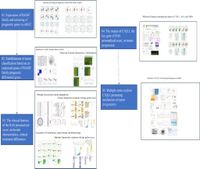Recent advancements in cancer research have illuminated the molecular underpinnings of clear cell renal cell carcinoma (ccRCC), the most prevalent subtype of kidney cancer, which accounts for approximately 70% of renal cell carcinoma cases. A recent study published by a team affiliated with the Affiliated Hospital of Putian University has unveiled critical insights into the roles of RASSF family proteins in ccRCC, leading to the identification of distinct molecular subtypes and potential treatment strategies aimed at improving patient outcomes.
The study examined the expression patterns of RASSF genes in 573 ccRCC samples sourced from renowned databases including The Cancer Genome Atlas (TCGA) and Gene Expression Omnibus (GEO). By clustering these samples, researchers classified patients into two molecular subtypes, each associated with different clinical outcomes: one subtype exhibited a poorer prognosis in comparison to the other. Notably, RASSF genes have been recognized for their tumor-suppressive capabilities, influencing crucial cellular mechanisms like apoptosis and cell migration.
One of the key discoveries of the research was the development of a RAS scoring system. According to the authors, “A higher RAS score correlated with advanced disease and worse outcomes but indicated a favorable response to specific inhibitors.” This score allows clinicians to assess prognosis and tailor treatment strategies based on the distinct characteristics of these subtypes.
Understanding the mechanisms underlying tumor progression in ccRCC, the researchers further focused on the role of the gene C1QL1. This gene was found to have elevated levels in patients displaying advanced disease states, emphasizing its potential as a novel therapeutic target. Notably, the authors emphasized that, “Understanding C1QL1’s role may facilitate the development of novel therapeutic approaches,” underscoring its relevance in the context of personalized medicine.
Historically, ccRCC poses significant challenges with high rates of recurrence and metastasis, even post-surgery. Approximately 30–40% of patients face recurrence after surgical interventions, necessitating ongoing research to improve early detection and treatment methods. Conventional therapies have often proved ineffective, making advanced options like targeted therapy and immunotherapy critical for managing advanced ccRCC. This study positions the RASSF family of proteins as integral to developing targeted therapies and highlights the necessity for further exploration of C1QL1 in the context of ccRCC treatment.
The methodology employed in this research included comprehensive bioinformatics analysis, taking advantage of large patient datasets to assess gene expression profiles across clinical stages. The application of tools like GeneMANIA allowed researchers to explore gene interactions effectively, leading to significant findings regarding the functional roles of RASSF family members. Through clustering techniques, researchers established clear distinctions in survival rates and therapeutic responses between the identified subtypes.
Among the critical insights gained from this research is the establishment of a correlation between high RAS scores and unfavorable clinical outcomes. The high-score patient group exhibited distinct features, including poorer overall survival rates and a greater presence of genetic mutations associated with aggressive disease phenotypes. Moreover, evaluation of treatment responses revealed that high-score patients showed lower sensitivity to conventional chemotherapy agents such as cisplatin and gemcitabine, indicating the need for personalized treatment plans that consider individual genetic landscapes.
As ccRCC continues to present significant challenges in clinical management, understanding the diverse mechanisms driving tumor progression becomes imperative. This study contributes to the growing body of knowledge aimed at characterizing ccRCC at a molecular level. Researchers advocate for ongoing investigations into the RASSF gene family and C1QL1 to facilitate the development of more sophisticated and targeted therapeutic strategies.
In conclusion, the findings from this study stress the importance of personalized medicine in treating ccRCC and the potential of RASSF-based molecular subtypes to be utilized as prognostic markers. With the exploration of C1QL1 as a promising candidate for therapeutic targeting, there remains considerable potential for these insights to translate into improved outcomes for patients facing this aggressive disease.




